An incredible friend of mine, Naomi Abankwah, had an incredible conversation with me last year and it has stuck with me. The topic? African-American hair.
I grew up in a small town that was a primarily White community, so my understanding of the African-American lifestyle was a bit unclear until I came to Denison. I enjoy learning about culture and I always try my hardest to engage with topics that I’m unfamiliar with. So, I asked Naomi about the process of taking care of Black hair and her response was unforgettable.
Naomi looked at me and laughed. I was confused, but once she started explaining the process of her hair care, I understood.
Many people don’t realize the effort it takes to care and maintain Black hair. It’s like entering a whole other world. A world that many of us should, out of respect, explore. In fact, there is a Hair Type Chart that allows women to identify their hair type and manage it in the healthiest way. The remainder of this piece is based on information provided by a few friends that I personally interviewed about the subject. I am not claiming that I know the entirety of what it takes to upkeep Black hair, but I hope that the pieces I present in this article are enlightening for many.
Flat-Ironing
My roommate, Courtney Broady, a junior Biology major at Denison gave me an insight on her hair care upkeep. She also let me in on a secret; the Curly Hair Community is DEFINITELY a thing and it’s pretty cool. Courtney flat-irons her hair, which as I found out, is a three to four hour process. Courtney washes and conditions her hair once a week, which takes about an hour. After, she blow-drys for about 45 minutes to an hour. Because Courtney has such long hair, she has her mother help blow-dry and then eventually straighten which can take a little over an hour. Courtney has flat-ironed her hair since she was in middle school and has dedicated many hours to her upkeep. She sleeps with a bonnet, nightly, to keep her hair in place and soft for the morning.
Natural
On the weekends, I work at Michael Kors, and one of my supervisors, Yvette Purser, talked to me a bit about her natural upkeep process. Yvette has been wearing her hair naturally since her senior year in high school and admits that it’s much easier to care for than her past methods of relaxing and flat-ironing. At first, Yvette admitted that it was pricey and a bit frustrating at times, but after a few years of following through, she doesn’t find it as difficult. She, as Courtney does, washes and conditions her hair once a week and after her hair drys, she uses product to exemplify her curl definition.
Twisting and Wigs
These words are directly taken from anonymous source.
—-
“I used to wear wigs, which is much better for my hair because it doesn’t pull at it as much. For many Black people wigs are a good protective style because we can put our hair in braids or twists underneath them so our hair can be protected. However, I decided I wanted to change it up for a bit and show my natural hair because I felt like it. Plus, in my protective style it grew quite a bit since I wasn’t constantly manipulating it. That’s the thing about natural hair, especially those with a tighter curl hair pattern, also known as Type 4 hair, our hair is very very fragile and is prone to breaking. My hair also has low porosity, meaning that its harder to get moisture in it. There are 3 types of porosity though: low, high, and normal. Knowing that my hair is fragile and low on moisture, I usually finger de-tangle rather than use combs or brushes because my hair tends to break easier and using my hands is much more gentle on my hair. To make sure that I get good moisture I use the lco method. Meaning that I usually add liquid to my hair (water), then a cream (moisturizer) and finally seal it with an oil (coconut oil or almond oil). It’s important for me to use oil last because it makes sure that my moisturizer stays in my hair longer as my hair is low porosity. When I style my hair to get my big curls, I use a styling gel on top of my oil to get the style to hold. For my hairstyle that I wore today, I had to section my hair into little squares, twist my hair using two strands and then coil it into a little bun or tower called Bantu knots and then let them dry overnight before taking them out in the morning. This process usually takes me a long time, almost 2-3 hours because my hair is so thick, so upkeep of natural hair takes a lot of effort. This doesn’t even take into account how long it takes me to wash my hair, condition it, and de-tangle it. I can’t just wash my hair and let it air dry as it would be a tangled mess. I usually try not to use heat on my hair so I section it into manageable buns, that have been de-tangled. My hair is very very prone to tangling because my curls want to interlock with each other.”
Thank you to Courtney, Yvette, and my anonymous source. This is dedicated to all of you and the entire Curly Hair Community.


